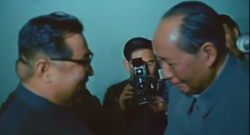
The following is a list of international trips made by Kim Il Sung during his tenure as General Secretary of the Central Committee of the Workers' Party of Korea, Premier and President of North Korea. His first international state visit was to the Soviet Union in 1949.
Contents
The number of visits per country where he traveled are: [1]
- One visit to Albania, Indonesia, Mauritania and Algeria
- Two visits to Czechoslovakia, East Germany, Hungary, Poland, Mongolia, North Vietnam and Yugoslavia
- Three visits to Bulgaria and Romania
- Ten visits to the Soviet Union
- Eleven visits to China



